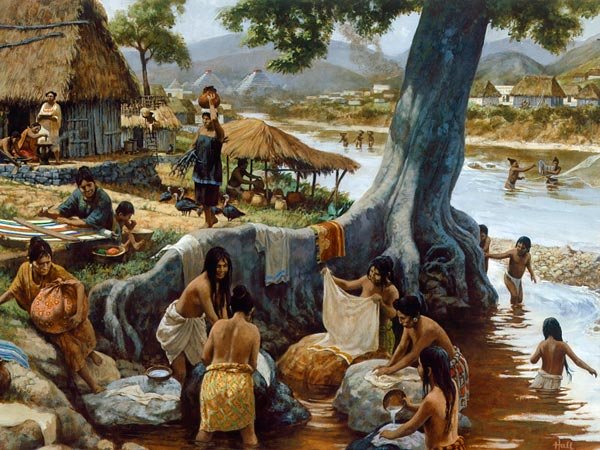Monument text’s “poetic flourish” confuses modern minds, experts say.
A painting of everyday life in a Maya village.
Illustration by H. Tom Hall, National Geographic
John Roach
for National Geographic News
It’s remotely possible the world will end in December 2012. But don’t credit the ancient Maya calendar for predicting it, say experts on the Mesoamerican culture.
It’s true that the so-called long-count calendar—which spans roughly 5,125 years starting in 3114 B.C.—reaches the end of a cycle on December 21, 2012.
That day brings to a close the 13th Bak’tun, an almost 400-year period in the Maya long-count calendar.
But rather than moving to the next Bak’tun, the calendar will reset at the end of the 13th cycle, akin to the way a 1960s automobile would click over at mile 99,999.9 and reset to zero.
“We, of course, know that really means a hundred thousand [miles] and not zero,” said William Saturno, an expert on Maya archaeology at Boston University.
“So, is [the end of Bak’tun 13] a large period ending? Yes. Did the Maya like period endings? Yes,” Saturno said.
“Would this have been a period ending they thought was wicked cool? You bet. The biggest period endings they experience are Bak’tun endings.”
But “was it predicted to be the end the world? No. That’s just us.”
Instead, for the Maya, the end of the long count represents the end of an old cycle and the beginning of a new one, according to Emiliano Gallaga Murrieta, the Chiapas state division director of Mexico’s National Institute of Anthropology and History.
“It is like for the Chinese, this is the Year of the [Rabbit], and the next year is going to the Year of the Dragon, and the next is going to be another animal in the calendar,” Gallaga said.
Maya Prophecy for End of the World?
Written references to the end of Bak’tun 13 are few. In fact, most Maya scholars cite only one: a stone tablet on Monument 6 at the Tortuguero archaeological site in Mexico’s Tabasco state.
What exactly the tablet says, though, is a mystery, because the glyphs in question are partially damaged.
Nevertheless, scholars have taken several stabs at translations, the most prominent in 1996 by Brown University’s Stephen Houston and the University of Texas at Austin’s David Stuart.
Houston and Stuart’s initial interpretation indicated that a god will descend at the end of Bak’tun 13. What would happen next is uncertain, although the scholars suggested this might have been a prophecy of some sort.
This 1996 analysis was picked up “on many New Age websites, associated forum discussions, and even a few book chapters” as evidence that the Maya calendar had predicted the end of the world, according to Stuart.
Houston and Stuart, however, independently revisited the glyphs recently and concluded that the inscription may actually contain no prophetic statements about 2012 at all.
Rather, the mention of the end of Bak’tun 13 is likely a forward-looking statement that refers back to the main subject of the inscription, which is the dedication of Monument 6.
In an October blog post about his conclusions, Stuart makes an analogy to a scribe wanting to immortalize the New York Yankees’ 1950 sweep of the Philadelphia Phillies in that year’s World Series.
If this writer were to use the Maya rhetorical device thought to be in Monument 6’s inscription, the text might read:
“On October 7, 1950, the New York Yankees defeated the Philadelphia Phillies to win the World Series. It happened 29 years after the first Yankees victory in the World Series in 1921. And so 50 years before the year 2000 will occur, the Yankees won the World Series.”
Written this way, Stuart notes, the text mentions a future time of historical importance—the 50-year anniversary of the victory—but it does so in reference to the event at hand, i.e., the 1950 game.
“This is precisely how many ancient Maya texts are structured, including Tortuguero’s Monument 6,” Stuart writes.
2012 Apocalypse Just Poetic Flourish
According to INAH’s Gallaga, this structure of Maya texts is what has confused modern minds, given our penchant for literal, straightforward reading.
Even if the Monument 6 inscription refers to a god coming down at the end of Bak’tun 13, it isn’t a statement about the end of the world, he said.
“They are writing in a more poetic sense, saying, Well, on the 21st of December 2012, the god is going to come down and start a new cycle and the old world is going to die and the new world is going to be reborn—just to make it more poetic.”
Saturno, the Boston University archaeologist, agreed that the reference to a specific date is clear in Monument 6, but added that “there’s no text that follows and says, Herein will be the end of the world, and the world will end in fire. … That’s not anywhere in the text.”
Rather, Saturno said, the hype around 2012 stems from dissatisfied Westerners looking to the ancients for guidance, hoping that peoples such as the Maya knew something then that could help us through difficult times now.
In any case, even if the ancient inscriptions explicitly predicted the end of the world, Saturno wouldn’t be worried, given the Maya track record with long-range prophecy.
“They didn’t see [their] collapse coming. They didn’t see the Spanish conquest coming.”
Source: National Geographic News
Opinions expressed in the article are those of National Geographic and not necessarily The Lodge at Chaa Creek.

Now here’s an article that makes sense!
I was suggested this approach blog by great cousin. I’m now not sure whether or not this approach submit is normally developed by the dog like nobody better know these sort of targeted about great problem. You’re amazing! Thanks!